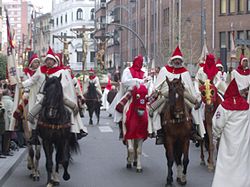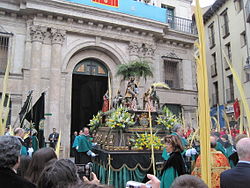You can help expand this article with text translated from the corresponding article in Spanish. (September 2022) Click [show] for important translation instructions.
|
| Holy Week in Valladolid | |
|---|---|
 Procession in Plaza Mayor | |
| Official name | Semana Santa de Valladolid |
| Observed by | Valladolid, Spain |
| Type | Religious, Historical, Cultural |
| Significance | Commemoration of the passion, death and resurrection of Jesus |
| Celebrations | Processions |
| Begins | Palm Sunday |
| Ends | Easter Sunday |
| 2023 date | April 2 - April 9 |
| 2024 date | March 24 - March 31 |
| 2025 date | April 13 - April 20 |
| 2026 date | March 29 - April 5 |
| Frequency | Annual |












The Holy Week in Valladolid is one of the main tourist attractions, and cultural and religious events of Valladolid and the surrounding province during Holy Week in Spain. It boasts of renowned polychrome sculptures, created mainly by sculptors such as Juan de Juni and Gregorio Fernández,[1] who were active when the city served as the imperial court. The city's National Sculpture Museum has a total of 42 images (distributed in the corresponding pasos) for the processions.[2] The Holy Week in Valladolid is known to depict the Passion with great fidelity, rigor and detail.[3]
In addition to the artistic and catechetical (instructional) value of its religious imagery, the Week is characterized by devotion, sobriety, silence[4] and respect for the brotherhoods and the public, and by unique acts such as the "General Procession of the Sacred Passion of the Redeemer"[5] and "Sermon of the Seven Words" in the Plaza Mayor, which recalls the autos de fé (ritual of public penance) of the 16th century. For these reasons, this celebration was declared a Fiesta of International Tourist Interest in 1980 (the first Holy Week celebration in Spain to have such a designation), and in 2014 work began to have it recognized as a representation of intangible cultural heritage by UNESCO.[6]
- ^ The Holy Week: Ora et labora Archived 2014-06-06 at the Wayback Machine
- ^ Artículo del Museo Nacional de Escultura sobre la conservación de las imágenes y los protocolos de actuación ante la salida de imágenes en procesión
- ^ Enrique Gavilán. El hechizo de la Semana Santa: sobre el lado teatral de las procesiones de Valladolid.
- ^ The Holy Week in Valladolid and the sounds of silence Archived 2014-06-06 at the Wayback Machine
- ^ The great day of the Holy Week finally arrives
- ^ El Confidencial: Valladolid inicia la carrera para que su Semana Santa sea patrimonio mundial Archived 2015-02-01 at the Wayback Machine
